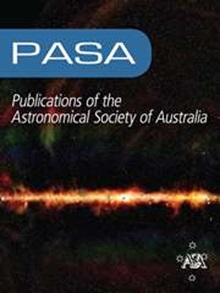基于MWA VCS数据的脉冲星候选星图像搜索
IF 4.6
3区 物理与天体物理
Q1 ASTRONOMY & ASTROPHYSICS
Publications of the Astronomical Society of Australia
Pub Date : 2023-01-25
DOI:10.1017/pasa.2022.59
引用次数: 1
摘要
脉冲星在过去的几十年里被广泛研究,并被证明是探索各种物理学的工具。发现更多以低无线电频率发射的脉冲星对我们进一步了解光谱特性和发射机制至关重要。默奇森宽场阵列电压捕获系统(MWA VCS)通常用于低频脉冲星的研究和发现新的脉冲星。MWA VCS提供了记录来自所有单个天线(瓦片)的复杂电压的独特机会,这些天线可以离线波束形成或以毫秒时间分辨率相关/成像。设计基于图像的方法来寻找脉冲星候选者,这些方法可以在波束形成的数据中得到验证,可以加速整个过程,并导致更多的脉冲星探测。基于图像的脉冲星候选搜索可以减少所需的绑阵波束数量,提高计算资源效率。尽管在MWA VCS图像中搜索脉冲星候选者的灵敏度损失为$ $ $ $ $ $ $,但我们可以探索更大的参数空间,可能导致发现高频巡天错过的脉冲星,如陡峭光谱脉冲星,外来双星系统,或由于传播效应而在高时间分辨率时间序列数据中被遮蔽的脉冲星。基于图像的搜索对于探测使用MWA的传统波束形成搜索(例如在高色散测量下)无法探测的部分参数空间也是必不可少的。本文介绍了双处理MWA VCS数据的创新方法和能力,即形成1-s的能见度和天空图像,在这些图像中寻找候选脉冲星,并通过形成绑阵波束进行验证。我们开发并测试了基于图像的方法来寻找脉冲星候选者,这些方法基于脉冲星的特性,如陡峭的光谱指数、极化和可变性。这些方法的有效性已经在已知的脉冲星上得到了验证,并从一些脉冲星的灵敏度和低频频谱转换方面解释了主要的局限性。没有候选者被证实是一颗新的脉冲星,但这种新的能力现在将应用于更大的观测子集,以加速MWA的脉冲星发现,并可能加快SKA-Low未来的搜索速度。本文章由计算机程序翻译,如有差异,请以英文原文为准。
Image-based searches for pulsar candidates using MWA VCS data
Abstract Pulsars have been studied extensively over the last few decades and have proven instrumental in exploring a wide variety of physics. Discovering more pulsars emitting at low radio frequencies is crucial to further our understanding of spectral properties and emission mechanisms. The Murchison Widefield Array Voltage Capture System (MWA VCS) has been routinely used to study pulsars at low frequencies and discover new pulsars. The MWA VCS offers the unique opportunity of recording complex voltages from all individual antennas (tiles), which can be off-line beamformed or correlated/imaged at millisecond time resolution. Devising imaged-based methods for finding pulsar candidates, which can be verified in beamformed data, can accelerate the complete process and lead to more pulsar detections. Image-based searches for pulsar candidates can reduce the number of tied-array beams required, increasing compute resource efficiency. Despite a factor of
$\sim$
4 loss in sensitivity, searching for pulsar candidates in images from the MWA VCS, we can explore a larger parameter space, potentially leading to discoveries of pulsars missed by high-frequency surveys such as steep spectrum pulsars, exotic binary systems, or pulsars obscured in high-time resolution time series data by propagation effects. Image-based searches are also essential to probing parts of parameter space inaccessible to traditional beamformed searches with the MWA (e.g. at high dispersion measures). In this paper we describe the innovative approach and capability of dual-processing MWA VCS data, that is forming 1-s visibilities and sky images, finding pulsar candidates in these images, and verifying by forming tied-array beam. We developed and tested image-based methods of finding pulsar candidates, which are based on pulsar properties such as steep spectral index, polarisation and variability. The efficiency of these methodologies has been verified on known pulsars, and the main limitations explained in terms of sensitivity and low-frequency spectral turnover of some pulsars. No candidates were confirmed to be a new pulsar, but this new capability will now be applied to a larger subset of observations to accelerate pulsar discoveries with the MWA and potentially speed up future searches with the SKA-Low.
求助全文
通过发布文献求助,成功后即可免费获取论文全文。
去求助
来源期刊
CiteScore
5.90
自引率
9.50%
发文量
41
审稿时长
>12 weeks
期刊介绍:
Publications of the Astronomical Society of Australia (PASA) publishes new and significant research in astronomy and astrophysics. PASA covers a wide range of topics within astronomy, including multi-wavelength observations, theoretical modelling, computational astronomy and visualisation. PASA also maintains its heritage of publishing results on southern hemisphere astronomy and on astronomy with Australian facilities.
PASA publishes research papers, review papers and special series on topical issues, making use of expert international reviewers and an experienced Editorial Board. As an electronic-only journal, PASA publishes paper by paper, ensuring a rapid publication rate. There are no page charges. PASA''s Editorial Board approve a certain number of papers per year to be published Open Access without a publication fee.

 求助内容:
求助内容: 应助结果提醒方式:
应助结果提醒方式:


